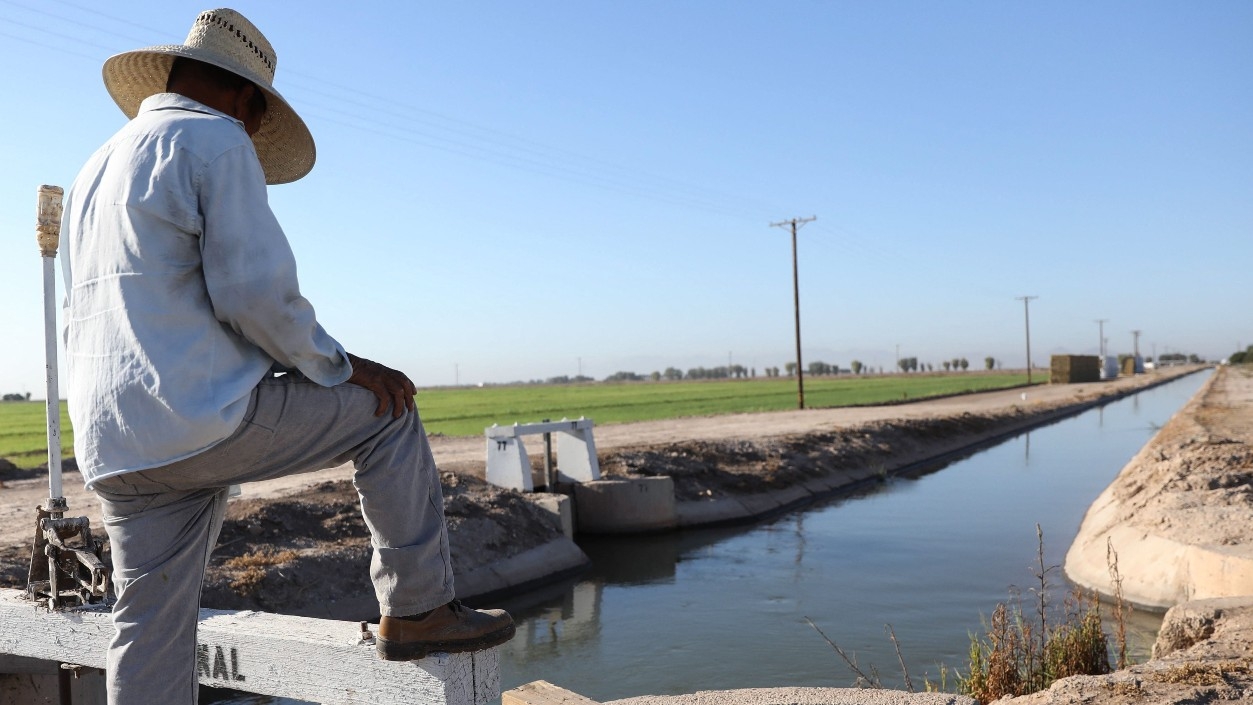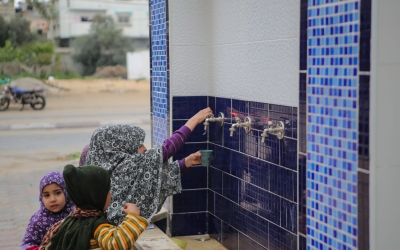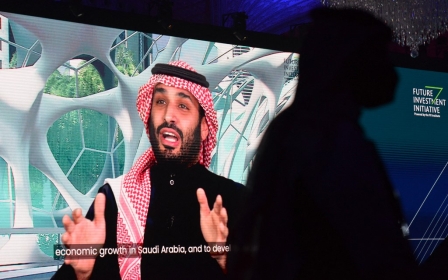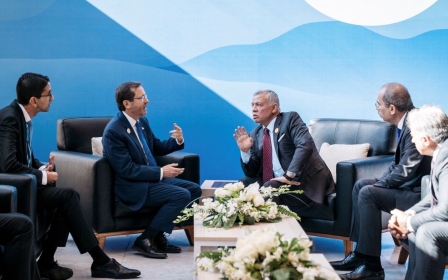Drought-stricken US southwest pays the price for Gulf-owned farms exporting 'virtual water'

In Arizona's La Paz county, about two and a half hours from the state capital Phoenix, the community has been facing an increasingly severe issue. They're running out of water.
As the entire American southwest faces the worst drought in 1,200 years, underground aquifers are being looked to as a lifeline. But water workers in the county have recently noted that some wells are running dry.
At the same time, Saudi and Emirati companies owning or leasing farmland in the area are able to pump as much water as they like. The companies, which have been farming there for the past several years, have been faced with increasing concerns from local communities that are struggling to access clean water.
"Saudi Arabia - Fondomonte is the name of the company - purchased farmland in the Vicksburg area. They can pump as much water out from underneath the ground that they want. There's no restrictions on their farmland," Holly Irwin, a county supervisor in La Paz, told Middle East Eye.
"We need to get a grip on how much water we actually have in these basins because they're pumping more water out than is able to be put back into the ground."
Recent reporting from The Arizona Republic found that Saudi Arabia's Fondomonte pays only $25 per acre for the water that it uses from the Butler Valley in Arizona - one-sixth of the market price for the land, according to a realtor in the area.
And while there is no concrete data on how much water it pumps out of aquifers, a State Land Department report estimates Fondomente using as much as 18,000 acre-feet every year - enough water to supply 54,000 single-family homes. The population of La Paz is about 16,000 people.
According to the report, the value of the water Fondomonte uses could be anywhere from $3 million to $3.9m a year, while it is only paying about $86,000 a year.
"We're not really sure why those discounts were given to them," said Irwin.
Farmland across Arizona and California, within the Colorado River basin, have played pivotal roles in the development of the agricultural sectors of Saudi Arabia and the United Arab Emirates.
Fondomonte, a Saudi subsidiary, and Al Dahra, an Emirati company, have bought out thousands of acres in the US southwest for the farming of water-intensive crops, including alfalfa.
For Saudia Arabia's Fondomonte, that alfalfa is sent back to the kingdom - where it is used to feed cows, helping to sustain its dairy industry.
But as the companies continue to pump as much water as they want for little to no cost, the southwest is grappling with its own water laws that have led to inequity of access.
Saudi and UAE using farmland abroad
By 2018, Saudi Arabia had completed its ban on growing alfalfa in the country, maintaining the crop's production put too much of a strain on its domestic water supply. Instead, it has looked to other countries, including the US, to make up for this production deficit, as it needs alfalfa to continue feeding its dairy herds.
In 2012, Saudi Arabia's Fondomonte acquired 30,000 acres of land in Argentina. Two years later, they purchased 10,000 acres of land in Arizona, for $47m.
'Such a disproportionate amount of the total water resources that are used by humans are going to alfalfa'
- Alida Cantor, Portland State University
In 2016, they bought 1,700 acres in Blythe, California, just off the Colorado River, for a price of $32m. According to the US Department of Agriculture, the kingdom owned 18,586 acres of agricultural land as of 2020.
And Riyadh has been clear as to its intentions. Arab News reported the transaction was part of "continuous efforts to improve and secure [the company's] supply of the highest quality alfalfa hay from outside the kingdom to support its dairy business".
"It is also in line with the Saudi government's direction toward conserving local resources," the paper reported in March 2014.
Meanwhile, according to the USDA, the UAE owns nearly three times as much agricultural land - 46,496 acres.
The Emirati company Al Dahra grows 30,000 acres of alfalfa, garlic, and onion in Arizona and California, according to the company's website.
The ability of these rich Gulf nations to capitalise on natural resources overseas has helped create a boon for their own agricultural sectors.
The agricultural output of Saudi Arabia in 2021 was $19bn, the highest in five years. And in the UAE, its agricultural production increased by 12 percent from 2019 to 2020, to reach close to $4bn.
And their agricultural growth in other countries comes with no environmental costs for them.
"The producing region bears the cost of these environmental impacts, and the consumer on the other side of the world doesn't perceive it or have a direct notion of the environmental impacts," Paolo D'Odorico, a professor of ecohydrology and water resources at UC Berkeley, told MEE.
Middle East Eye reached out to Al Dahra and Fondomonte for comment on this story, but did not receive a response by time of publication.
Al Dahra told the Arizona Republic in a story published in 2019: "Water resources in Arizona must be managed wisely in order to preserve our quality of life and to protect the state's economic health," Al Dahra said. "The company is fully committed to Arizona and plans to remain here for the long term."
'Fossil aquifers'
The ability of a country to grow and produce crops using another country's natural resources can be quite lucrative. However, the exporting of "virtual water" - water embedded in products such as produce and crops - also has a huge environmental impact on the local communities.
In California and Arizona, large swathes of fields are full of alfalfa. It is one of the main crops that Fondomonte produces on its farms. And that crop, which is used to feed cattle, is all exported back to Saudi Arabia.
Alfalfa is a very water-intensive crop. A 2020 study found it responsible for 13 percent of the entire contiguous US's water usage, and nearly 40 percent of the water usage for the Colorado River basin.
"Such a disproportionate amount of the total water resources that are used by humans are going to alfalfa. And all things considered, it's a relatively low-value crop. It doesn't make that many jobs," said Alida Cantor, a political ecologist and assistant professor at Portland State University.
"It just stands out to me as like a particularly poor thing to be using so much water resources for," Cantor told Middle East Eye.
And as they continue to pump out water from aquifers, scientists worry that they are pumping at such a rate that they will not be able to be replenished. Amid the massive drought the region is facing, with dwindling surface water supplies, these aquifers are the area's last option for water.
A 2020 Arizona Department of Water Resources report found that groundwater levels in the Willcox basin in southeastern Arizona dropped eight feet a year in some areas from 2008 to 2018. A 2018 report estimated that at least roughly 58.6 billion gallons were drawn out of the aquifer each year from 1995 to 2015.
"Some of the aquifers will never be refilled, they are considered 'fossil water'," said Andre Daccache, an assistant professor of biological and agricultural engineering at UC Davis.
Cantor added, in terms of environmental concerns, the US needs to also look to its own "virtual water" footprint abroad.
"If we want to worry about the water coming from the American southwest and getting shipped to Saudi Arabia, we also need to think about the impacts of goods that are produced elsewhere in the world, and what are the local environmental impacts on those that are brought to the United States," she said.
Water laws in the US southwest
The purchases of these water rights have caused outrage in recent years, with news headlines reading that Saudi Arabia is plundering all of Arizona's water and threatening its water supply. Yet the issue has to deal with the way that water rights have been established in the southwest.
"There are ways that it gets framed that to me risk getting into racist discourses around who ought to have access to resources," said Cantor.
Recent federal regulations have been put in place to limit the residential use of water in the region, despite the fact that 80 percent of the water obtained from the Colorado River basin is used for agriculture.
In some areas of Arizona, the use of groundwater from aquifers is completely unregulated, allowing largescale farms to pump out water with little pushback.
La Paz County's Irwin is working to change this and has spent the past few years on legislation aimed at regulating the use of groundwater in her municipality.
"Over the years I've worked I've been trying to work with the legislators I'm trying to get some sort of conservation measures or just being able to measure or meter [water usage] which nobody wants to talk about," she said.
"We've been trying to work on legislation to be passed to help protect the rural communities as far as the groundwater goes."
Yet the community of La Paz faces an uphill battle, as no bills to regulate groundwater have been passed in the state's legislature. And amid the gridlock, the Arab Gulf-owned farms are able to continue using up as much groundwater as they'd like, given a lucrative lack of restrictions.
"It's been one of the most challenging issues that I've faced since I've been in office, trying to struggle to get protection for the people," Irwin said.
Middle East Eye propose une couverture et une analyse indépendantes et incomparables du Moyen-Orient, de l’Afrique du Nord et d’autres régions du monde. Pour en savoir plus sur la reprise de ce contenu et les frais qui s’appliquent, veuillez remplir ce formulaire [en anglais]. Pour en savoir plus sur MEE, cliquez ici [en anglais].






